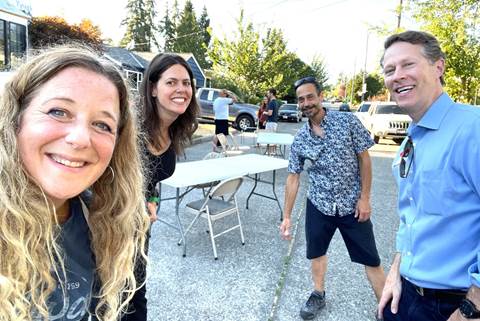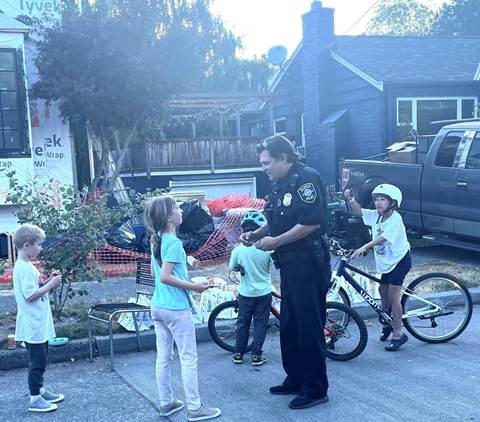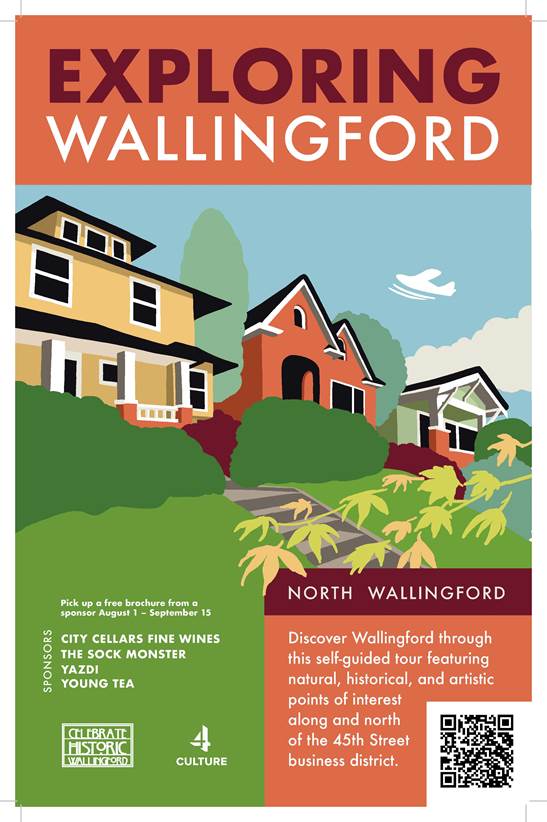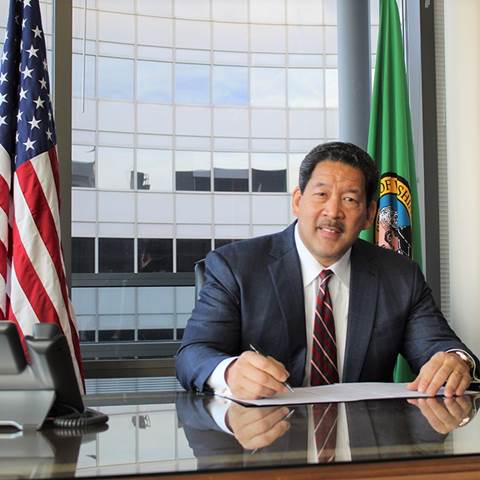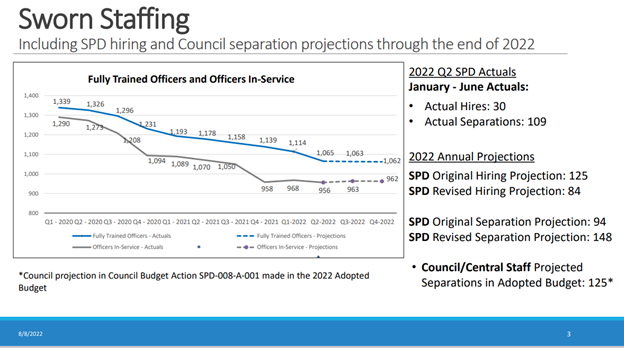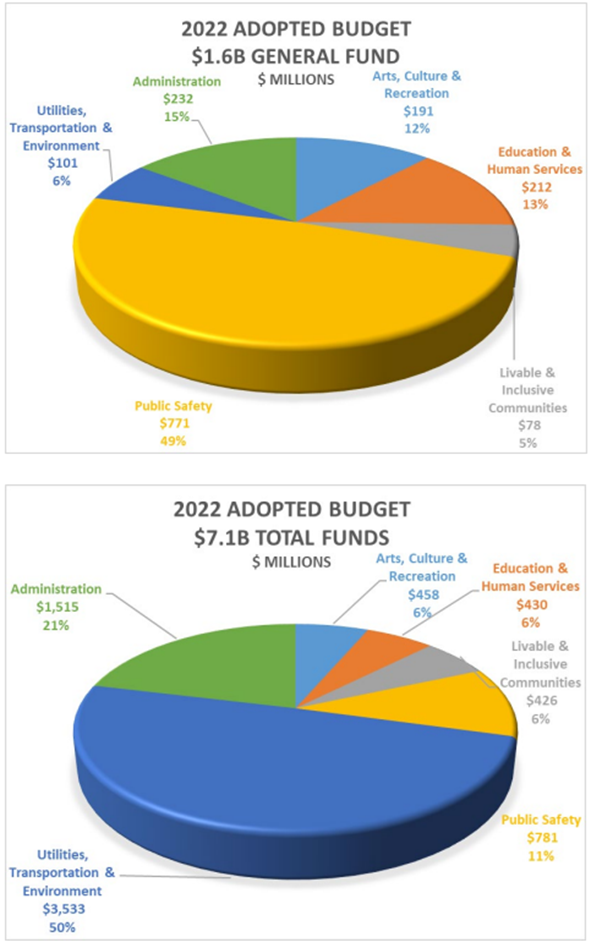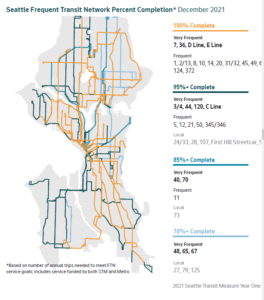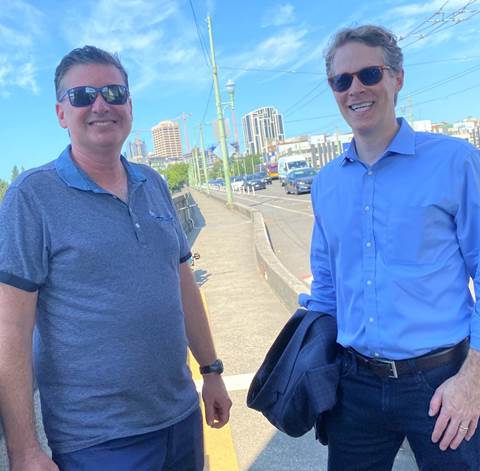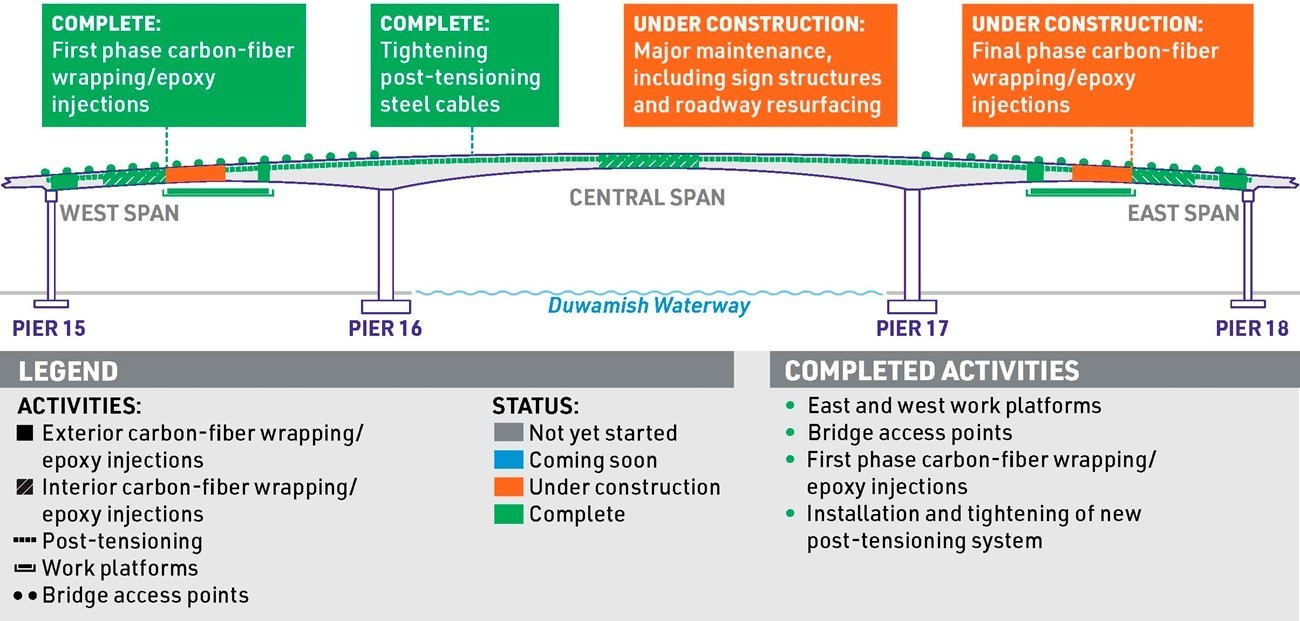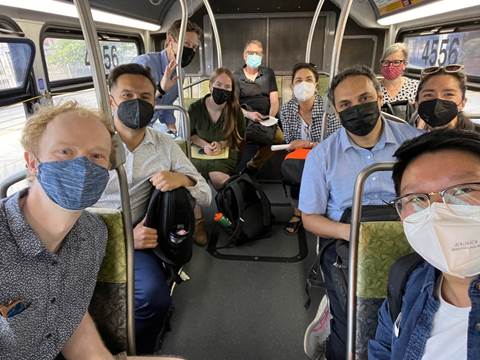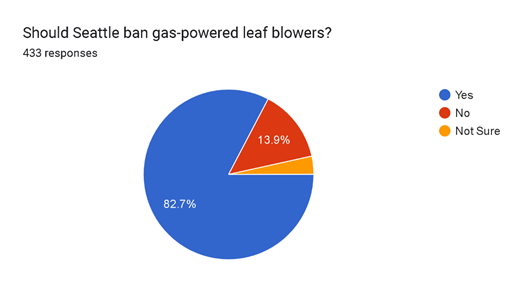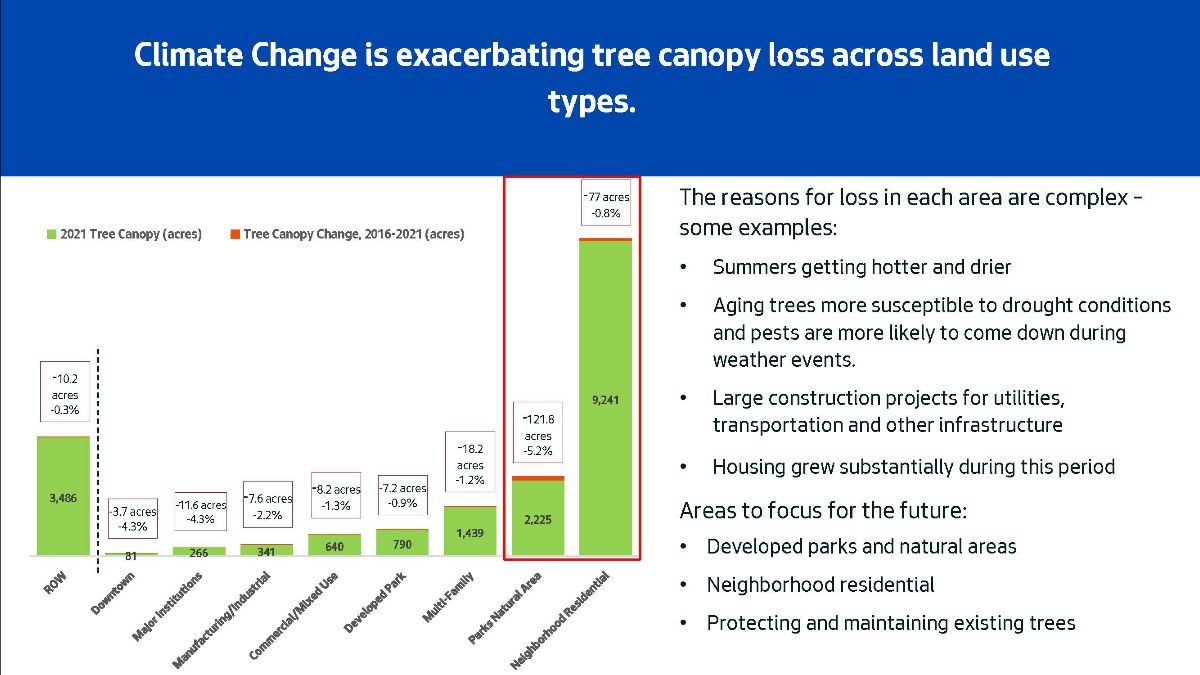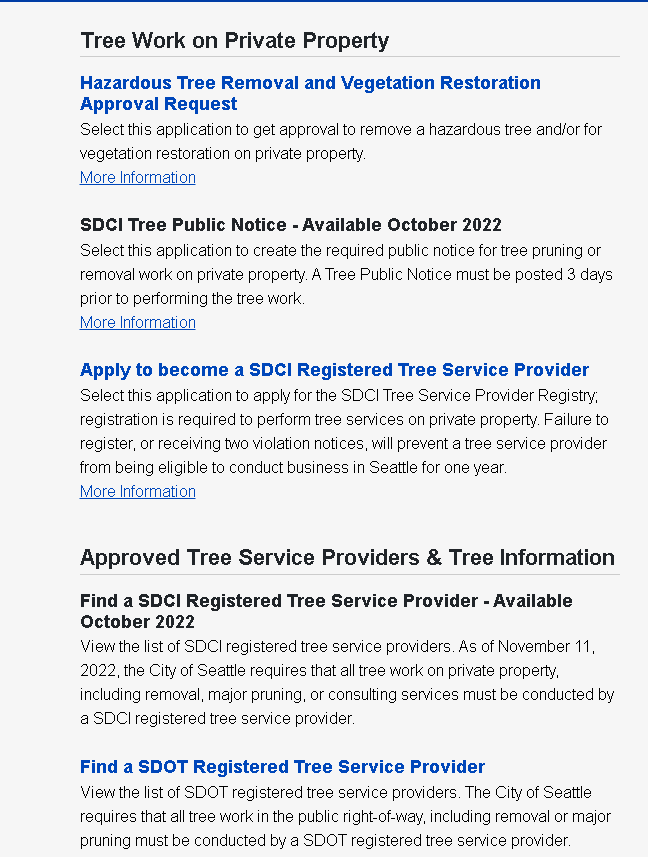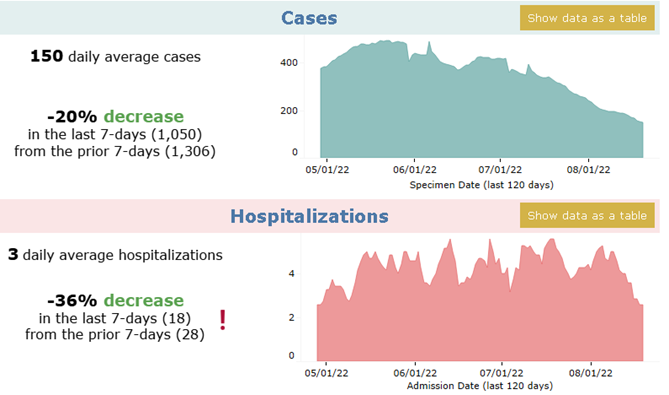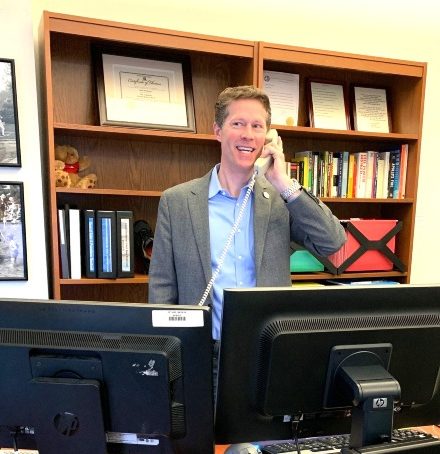Budget is Coming
Friends and Neighbors,
Let’s dive in. To round out your summer reading list, here’s our August newsletter:
- District 4: Engaging in the U District, View Ridge, Wallingford, Wedgwood, and more.
- Public Safety: recruitment plan passes and “National Night Out” revives.
- Budgets and Taxes: Budget is coming!
- Affordability: City planning process must encourage more low-income housing near transit.
- Transportation & Seattle Public Utilities Committee: new SDOT Director vetting, the Seattle Transit Measure, and more
- Public Health and Environment: Call to Action to phase out gasoline-fueled leaf blowers (Sept 6), bad news and good news on trees, beating the heat, Monkeypox update, and COVID stats
- Ways to Provide Input
DISTRICT 4
National Night Out Crime Prevention Block Parties
On August 2, 2022, I had fun attending 8 block parties from the U District to View Ridge. As you probably know, “Night Out” is national event on the first Tuesday of August for neighbors to enjoy time together on side streets in their community to connect and share food while heightening crime prevention awareness.
Our D4 neighbor Dr. Jacqueline Helfgott (leftside of photo above) is a Professor of Criminal Justice at Seattle University. She conducts an annual public safety survey (CLICK HERE). Along with dozens of other community leaders across Seattle, she and her neighbors organize a major block party for National Night Out every year.
Thanks to all neighborhood leaders who organized an event on their block so neighbors could get to know each other again. For other crime prevention needs, you can contact a Crime Prevention Coordinator by CLICKING HERE. I worked hard to secure funding for two Crime Prevention Coordinators in North Seattle: they are already hired and ready to meet with you to share crime prevention tips.
ADDENDUM: Wedgwood Community Picnic

The Wedgwood Community Council invites everyone to join them at the 5th annual Wedgwood Community Picnic! The picnic will take place on Saturday, September 10th, from 3 p.m. to 7 p.m.
View Ridge: Annual “Party in the Park” is Back!
The Great Wallingford Wurst Festival Returns!
(pre-COVID photo of the Great Wallingford Wurst Festival from their website)
The Great Wallingford Wurst Festival is a fun community event for families, including live music from 16 local musical acts, great food / beverages, bouncy houses, a “Fun Zone” filled with games and prizes for kids, a variety of crafts and vendors, a sweet shop, and an outdoor beer garden for those 21 and older. Friday, September 16, 2022 from 4:00 p.m. to 10:00 p.m. and Saturday, September 17, 2022 from 10:00 a.m. to 10:00 p.m. at the St. Benedict Catholic School Grounds between N. 48th and N. 49th Streets on Wallingford Ave. For more info, visit the Great Wallingford Wurst Festival Facebook page.
Exploring Wallingford
The organization Historic Wallingford has put together a self-guided tour: CLICK HERE. In addition to tours like this, you can learn more about Wallingford from several community organizations including the Wallyhood news blog, the Wallingford Chamber of Commerce, Wallingford Community Council, and Welcoming Wallingford.
Burke Museum (U District) Summer of Learning Event
This Sunday, August 28, youth and their families who participated in the Seattle Public Library’s Summer of Learning program (also known as “Superhero Summer”) can enjoy a free day at the Burke Museum (4300 15th Ave NE on the northwest corner of UW’s main campus). Families will have the opportunity to learn more about dinosaurs, fossils, Northwest Native art, plant and animal collections, and cultural pieces from across the globe. Even if you didn’t participate this summer, the Burke Museum is always a fun and edifying place to visit. For more info, CLICK HERE.
PUBLIC SAFETY
Mayor Harrell’s Plan to Recruit and Restore Police Staffing: APPROVED!
Mayor Bruce Harrell signing a bill into law earlier this year at City Hall.
Mayor Harrell signed his police officer recruitment legislation (Council Bill 120389) into law August 18, 2022 — as soon as he received the Council-approved bill from the City Clerk.
The departures of police officers continued at a higher-than-expected pace as of the 2nd Quarter of this year. SPD saw a whopping 109 separations during just the first six months of 2022, which essentially means they have practically blown through the estimates for the entire 12-month period. While SPD doesn’t have the full details yet, it was probably due in part to what I had noted in my June newsletter: “I’m afraid this attrition of officers AND detectives will be much worse next month because of a new State law (SHB 1701). Unfortunately, that new State law financially incentivizes officers eligible for retirement to retire by July 1, 2022 before a special benefit expires.”
Foreseeing this challenge a year ago, I introduced on September 10th, 2021 two budget amendments to fund between $1 million and $3 million dollars for SPD recruitment and retention. But, unfortunately, only 3 of my colleagues supported it. Since then, there was a very clear election last November, coupled with more recent data showing unacceptable increases in 9-1-1 response times and unacceptable increases in crime. So I’m grateful that the new Mayor’s recruitment incentives passed this month.
A remarkable and positive point made in Mayor Harrell’s plan: “As of May 2022, the number of trained and deployable officers — just 954 — is the lowest in over 30 years…Mayor Bruce Harrell’s goal is to increase the number of Seattle police officers who are authorized, funded, fully trained, and deployable to 1,450…”
Here’s Mayor Harrell’s statement when the Council approved his recruitment legislation, 8/16/2022:
“This is a positive step in the right direction as we seek to make Seattle a safe place for every neighbor and rebuild and restore the Seattle Police Department in line with our highest values, priorities, and aspirations. This challenge created over years cannot be solved overnight, but this plan will help move us forward.
“Police are but one piece of our plan to ensure public safety; however, they are a crucial element. Our police staffing crisis limits our deployment of officers, deteriorates emergency response times, and impacts investigative work. Combining improved SPD staffing with community-based programs, economic development efforts, and activation and environmental design strategies, we can make long-term progress creating safe neighborhoods for all the people of Seattle.
“Similarly, hiring incentives are but one piece of our recruitment plan – they demonstrate our urgency and dedication to staying competitive with departments across our region. Further, we’re prioritizing a diverse candidate pool, simplifying the application process, hiring recruiters, and pursuing education and career advancement opportunities for future officers. We are also focused on retaining current officers through a competitive economic package and commitment to officer wellness and morale.
“Above all else, the key to recruiting and retaining officers is the need to change the narrative in our city. To make Seattle a place where officers feel welcome and supported, where they know we value and respect their good work, where they can believe in our mission for safety for everyone, and where we acknowledge a shared commitment to constitutional, unbiased, innovative policing.
“I’m grateful for the Council’s thoughtful legislative engagement to strengthen and pass this plan. My administration is committed to swiftly implementing our plan, hiring needed officers, and delivering effective public safety for all communities.”
Here’s my statement when originally voting for Mayor’s recruitment legislation at the Public Safety Committee, 8/9/2022:
“Seattle police staffing is dangerously low and crime is unacceptably high. Our new mayor has a plan, so let’s get it done. Mayor Harrell announced his recruitment plan on July 13 and this legislation is needed to implement that plan, so I’m eager to pass the Council Bill today…
I receive emails from constituents every day expressing their concerns about public safety. We need to restore the detectives we lost so that we can solve crimes and we need to restore the community policing officers we lost so that we can prevent crimes.
As we continue to deepen accountability reforms and craft alternatives to respond to some behavioral health emergencies, I support the Mayor’s SPD recruitment plan and I look forward to supporting more efforts to RETAIN the highly qualified officers already here, continuing to serve our City admirably. We know it takes a long time to train and deploy new recruits. Thank you.”
– Councilmember Alex Pedersen
- For Mayor Harrell’s 8/16/2022 statement on City Council’s passage of the bill authorizing his police recruitment plan, CLICK HERE.
- For Mayor Harrell’s Recruitment Plan, CLICK HERE and HERE.
- For the video of the Mayor making his announcement and answering questions, CLICK HERE.
- For the SPD staffing report from City Council’s Central Staff report from August 9, 2022, CLICK HERE.
- To apply to be a Seattle police officer, CLICK HERE.
- For the Seattle Times July 22 editorial entitled, “It’s OK to say we’re funding the police,” CLICK HERE.
CITY BUDGET AND TAXES
The Fall Budget Season is Coming:
While some might imagine Councilmember Pedersen’s fiscal moderation as wielding an austere budget ax (or a sword made from Valyrian steel), he actually would like to see additional investments for several City priorities (and he would never wear fur)! Of course, fans of that TV drama will remember what happens to this character at the end of season 1.
In just one month, Mayor Harrell will propose his first budget as the City’s chief executive. Then your City Council will spend October and November reviewing, amending, and adopting the budget documents and related legislation. Typically, City Councils alter less than 10% of a mayor’s proposal, but that 10% ends up being very important to projects receiving – or NOT receiving – support as the money is shifted around. A revised revenue forecast in October sometimes produces additional funds to make that part easier, but not always.
You can always communicate your budget priorities to me at Alex.Pedersen@seattle.gov, to the entire City Council at Council@seattle.gov, and to the Mayor (CLICK HERE for his contact form).
Based on the priorities I continue to hear consistently from constituents, I’m hoping the Mayor’s budget proposal (expected by September 27) allocates ample funding to increase public safety and reduce homelessness. In addition, I would expect to see more investments in transportation safety, including pedestrian safety (especially in South Seattle) and bridge safety. As you may recall, I joined many residents, construction workers, and businesses who were disappointed when the executive branch turned down the $100 million in bridge safety bonds provided by City Council. Therefore, it will be important to see a budget from the executive that makes a clear and bold investment in bridges, to demonstrate that infrastructure issue is being taken seriously. This is especially important in light of the disturbing 2020 audit of our bridges and in anticipation of City Hall officials trying to convince Seattleites to renew a property tax for transportation that’s, thus far, failing to deliver on several promises for bridges. It’s also important to see follow-through on the 2020 “Internet for All” digital equity action plan and to fund the basics of safety, access, and cleanliness at all City parks and community centers. (Note: the separate Parks District budget we’ve been talking a lot about lately is just 20% of the budget for Parks & Recreation). And, of course, I’ll be eager to make sure District 4 priorities are met.
Ideally, the budget would minimize the “Administration” costs (which have increased at a disturbing rate from 14% in 2015 to 21% in 2022 for all funds) and would minimize the “Utility Taxes” (which essentially require the people and businesses paying their utility bills for electricity, trash, and water to subsidize the City’s General Fund on top of paying the full cost of the utilities). Personnel costs comprise the bulk of General Fund expenses (including base salaries for the 12,000 city government employees that average $100,000, plus benefits and pensions), so it’s important that labor contracts are appropriately negotiated.
City analysts recently confirmed the assessment my office reported in my June 2022 newsletter, “There is no budget deficit in city government…A simple amendment to increase flexibility for how we use JumpStart [employer payroll] tax revenues would enable us to plug the General Fund gap and still provide ample dollars for JumpStart’s important goals.” That’s because that relatively new business payroll tax will be raking in $294 million — at least $71 million more than originally anticipated for 2023 and it’s likely to rake in at least $84 million more than originally anticipated for 2024.
I’m grateful to our City Budget Chair Councilmember Mosqueda for proactively proposing a path to put in place a solution to the shortage in the City’s General Fund by temporarily shifting some of the dollars from the payroll tax fund. Shifting the higher than anticipated portion of the payroll tax revenues to the General Fund will still enable more than $200 million a year on the original spending plan for that payroll tax, the bulk of which is for low-income housing.
For a Seattle Times article from August 23, 2022 about our Budget Chair’s flexibility on temporarily sharing the City revenues, CLICK HERE.
(Note: “Public Safety” includes the 911 Call Center, the Emergency Operations Center, Firefighters, the City Attorney’s Office, and Seattle Municipal Court, as well as police).
- For the City budget adopted in 2022 and previous budgets, CLICK HERE.
- Regarding our current budget situation, our City Council Central Staff provided an exhaustive analysis for our 8/17/2022 Finance Committee. For a video of their presentation, CLICK HERE. For their PowerPoint summary, CLICK HERE. For their detailed memo, CLICK HERE. For their rough draft of how we might temporarily shift the higher than anticipated amounts from the payroll tax to address the 2023 and 2024 gaps in our City’s flexible General Fund, CLICK HERE.
AFFORDABILITY
Far too many people struggle to afford Seattle. I believe City Hall should do more to prevent residents and small businesses from being displaced. For example, City Hall should minimize increases in utility bills – everyone pays those bills and they’re regressive (lower income households pay a greater portion of their income for these basic expenses). We should continue to make it easier for lower income households to use lower cost transit to get around town. Your city government should control its own spending, so that we minimize increases in regressive taxes – not only minimizing sales taxes, but also minimizing property taxes – which negatively impact seniors on fixed incomes and can be passed along to renters in apartments and small businesses renting storefronts. City Hall can also do more to create affordable housing for low-income residents, not only with monetary subsidies but also with zoning.
City planning process must encourage more low-income housing near transit.
Let’s consider increasing density along transit lines and make it 100% low-income housing — because that’s what Seattle needs.
Seattle’s Office of Planning and Community Development (OPCD) is currently determining the scope of the required Draft Environmental Impact Statement (DEIS) for Seattle’s Comprehensive Plan overhaul, a 20-year planning document which State law requires City policymakers to update in a major way every ten years to establish parameters for land use, housing, and related policies. I appreciated OPCD’s presentation to the City Council’s Land Use Committee on May 11, 2022 and OPCD extending the formal comment period to August 22, 2022. (I noted this process in my June 2022 newsletter.) Here are OPCD’s initial 5 scoping alternatives for the new Comp Plan EIS: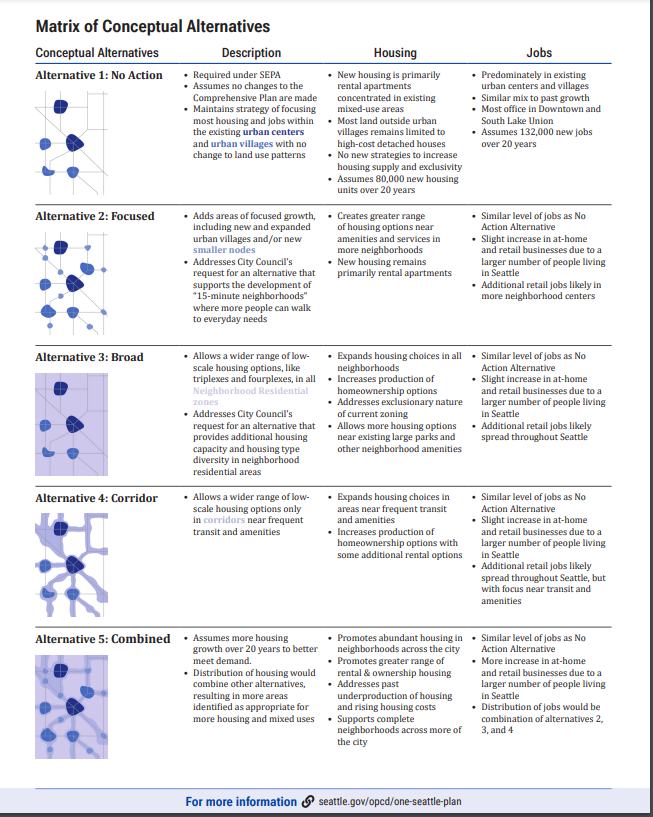
After careful consideration, I have concluded that the five initial alternatives presented by OPCD are inadequate in the face of our city’s affordable housing and homelessness crises, because no alternative prevents the demolition of existing affordable housing and no alternative requires the immediate onsite production of low-income housing (inclusionary zoning) in exchange for giving away increased density benefits to the for-profit real estate development market.
I, therefore, propose adding to the “One Seattle Plan” EIS an alternative that directly meets the goals of preventing displacement and producing low-income housing:
Alternative L: “the Low-Income Housing Alternative”:
(1) On existing frequent transit lines in Neighborhood Residential zones, permit multifamily developments of up to 6-unit stacked flats (per each 5,000 square foot lot) requiring 100% low-income housing [defined as rental units affordable to households below 50% of area median income (AMI) or homeownership units affordable at 80% of AMI] and (2) to prevent displacement, projects demolishing existing, affordable single family rentals or affordable multifamily housing in any zone would need to adhere to existing zoning (i.e. not allowed to profit from density increased after 2022). The “L” stands for low-income housing, because that’s what we need.
(Per the City’s Office of Housing for 2022, 50% AMI = $45,000 for a household of one person and $64,000 for a family of four. 80% AMI = $66,000 for a household of one person and $95,000 for a family of four.)
One may try to argue this new Alternative L could fit into OPCD’s Alternative 4 (see below for OPCD’s initial alternatives). I disagree that my proposed Alternative L would fit into Alternative 4, because OPCD’s Alternative 4 does not require any low-income housing, it does not prevent demolitions of affordable housing, and — in a move that could encourage an increase in the use of polluting single occupancy vehicles — it gives free reign to developers “near” frequent transit rather than strategically on transit lines.
Focus on Low-Income Housing Production:
If we want and need low-income housing to address our city’s affordability and homelessness crises, then let’s not beat around the bush — let’s require just that. The “housing of all types” slogan in the emerging “One Seattle Plan” or the catchphrase “Missing Middle” appears to give away all discretion to the private, for-profit market with no low-income housing requirements. The private market would surely attempt to maximize profits from changes in City policy by demolishing existing affordable housing and then developing small units and/or townhomes that are less accessible to people with impaired mobility, including seniors who want to age in place and families needing larger units along transit lines. When considering Alternative L, the focus must be not on the allowance for up to 6 units where 1 unit may currently exist on the frequent transit lines (increased density), but rather on the requirement that all these new units be low-income housing (100% of the units at 50% AMI for rental and 80% AMI for ownership). In other words, no low-income housing, no new upzone. The Comp Plan should be about increasing low-income housing, not altering City policies in a way that enriches landowners.
Prevent Displacement by Preventing Demolitions:
The materials from OPCD about “displacement” seem to imply that preventing displacement means allowing demolitions of existing housing to build more market-rate units. After already approving more than 25 upzones just three years ago, why quickly change our existing zoning again in a way that could encourage more demolitions, if demolitions equal displacements? Where do those Seattle residents go after their buildings are demolished and housing that is more expensive is built over two years later in its place?
If we truly want to prevent displacement, I believe the scope of the “One Seattle Plan” EIS should explicitly include assessments of the displacement impacts as well as proven mitigation measures for ALL the alternatives. Ultimately, the “One Seattle Plan” itself should include policies requiring the implementation of prevention and mitigation measures (such as immediate one-for-one replacement of affordable housing units lost) before the City grants final approval to another upzone or a proposed development project likely to result in increased displacement (i.e., requiring prevention and mitigation before displacement occurs).
We are still trying to understand the impacts, including demolitions of affordable housing, displacement of residents, and market-rate development capacity of the upzones of more than 25 neighborhoods in 2019. After the upzones of the University District by a previous City Council, we have seen demolitions of naturally occurring affordable housing at a higher rate than promised and we have seen nearly all developers opting out of building affordable housing in that neighborhood where many struggle to pay rent. A similar pattern appears to be unfolding in many of the communities upzoned recently in conjunction with “Mandatory Housing Affordability” (MHA) policies. Instead of providing affordable housing onsite, these developers have written a check to pay an “in-lieu” fee that the City uses to fund different projects approximately three years later somewhere else, which is not ideal. Words and assurances and resolutions don’t prevent displacement (or build low-income housing integrated into a neighborhood). Preventing demolitions prevents displacement. To learn from Seattle’s experience, let’s not confer additional development benefits to projects that will demolish existing affordable housing.
Council Bill 120325, approved by a majority of City Council this year, would have engaged a research university to collect data on existing rents throughout the City, thereby providing the block-by-block analysis needed to know where density can be increased in a way that avoids the demolition of existing affordable housing. The failure of the executive to adopt that legislation brings into question how City departments can accurately assess displacement risk and comply with the City’s displacement prevention policies. This lack of data on in-place rents for existing rental units further necessitates a clear alternative in the Comp Plan that more widely discourages demolitions of existing affordable housing (my Alternative L), as well as putting in place displacement mitigation requirements before upzones go into effect with any of the other alternatives.
More reasons to insist on encouraging only low-income housing and preventing demolitions:
One can argue that today’s allowable development capacity from the existing “2035 Comp Plan” adopted in 2016 can already accommodate the growth envisioned by the forthcoming 20-year Comp Plan dubbed the “One Seattle Plan”: a total of 112,000 new units is only 5,600 additional units per year. During the six year period from 2016 through 2021 (which includes two years of the pandemic), 47,514 new units were produced, which is an average of nearly 8,000 new units per year. Because sufficient capacity for “housing of all types” already exists, any additional upzones should serve the public benefit of enabling production of more low-income housing and should certainly not incentivize the demolition of it. Unless MHA fees are increased, MHA will be inadequate. City officials claimed MHA would produce 6,000 low-income units through 2025, and it has produced just 3,300 low-income units through 2021, while losing unquantified numbers of naturally occurring affordable units due to demolitions.
Therefore, in the midst of a homelessness crisis, the new Comp Plan should not be a vague, scattershot call to build “housing of all types” or “missing middle” (i.e., whatever builders deem most profitable that may or may not trickle down eventually to benefit the public), but rather a call to action to quickly create the housing the City needs the most — for those most in need: 100% low-income housing. We should not squander this ten-year opportunity by giving away to the private market additional profits and land values without receiving the public benefits the City actually needs: 100% low-income housing. The “One Seattle Plan’s” land use and housing policies should achieve these public benefit goals, which I believe requires the inclusion of Alternative L to create 100% low-income housing and prevent additional displacement.
I will continue to discourage City Hall from implementing new land use policies that give away additional monetary value to those who intend to demolish affordable housing and who are not building housing actually affordable to low-income households in Seattle during the homelessness crisis.
I’ll look forward to OPCD’s updated alternatives for the Draft EIS in October 2022 (ideally including my Alternative L), the Draft EIS in April 2023, and the Final EIS and Mayor’s Recommended Plan in April 2024.
TRANSPORTATION & SEATTLE PUBLIC UTILITIES COMMITTEE
(This is the Committee currently chaired by Councilmember Pedersen, so we provide extra information on its issues.)
Vetting Mayor’s Nominee to Lead SDOT
Gregory Spotts, Mayor Bruce Harrell’s nominee to become the next Director of the Seattle Department of Transportation (SDOT), joined Councilmember Pedersen last month on the University Bridge to discuss the need to address the safety of Seattle’s aging infrastructure, including this multimodal bridge ranked “poor” by the 2020 audit of Seattle’s bridges. You can see the U District growing in the background. It appears they both received the “blue shirt + sunglasses” memo!
Mayor Harrell’s nomination to lead and manage the Seattle Department of Transportation, its $700 million budget, and its 1,000 employees will dramatically shape how people and freight travel throughout our city safely and efficiently as we battle climate change. As Transportation Chair for the legislative branch of city government, I’m collaborating with my colleagues to conduct a thorough and transparent process for this important nomination. Together, we are following the methodical confirmation process outlined in Seattle Resolution 31868. I believe Seattle deserves a department director with a balanced and practical approach to urban transportation. I am grateful the Mayor provided us with such a strong candidate for consideration to lead this department upon which all Seattle residents and businesses rely.
As part of the standard process, Councilmembers submitted several written questions to the nominee. In his answers, Greg Spotts said he plans to “infuse the department with the values of responsiveness, innovation, transparency and accountability” and to “bring to life the Transportation Equity Framework by embedding these concepts and techniques in the daily activities and functions of the department.”
He will discuss his answers during his second appearance at our committee on Tuesday, September 6 at 9:30 a.m. It’s likely the Committee will vote on his nomination later that morning.
Here’s a sample of Mr. Spotts’ written answers to two questions on safety: pedestrian safety and bridge safety:
PEDESTRIAN SAFETY: Following a national trend, Seattle has seen an unacceptably high number of traffic collisions this year. How will you advance Seattle’s Vision Zero goal of zero traffic fatalities by the year 2030?
“I have already heard loud and clear that the number one priority of Seattleites is safety, no matter what mode a person chooses to use. That is why I am committed, between now and the New Year, to conducting a top-to-bottom review of the City’s Vision Zero program. Seattle continues to see an increase in deaths and serious injuries in our streets. While this trend is being seen across our country, it doesn’t lessen the tragedy that each and every one of these incidents represent.
“I’m eager to start working with the SDOT team to conduct this review of Seattle’s Vision Zero efforts. This review will include rigorous analysis of collision data to learn more about where crashes are occurring, the factors that are contributing to these incidents, and the effectiveness of safety-related interventions that have been installed on Seattle’s streetscape. I intend to work with the team to review our Vision Zero engineering strategies and push the team to consider new, innovative approaches to safety-focused street design. I am committed to publishing a new Vision Zero Action Plan within the first six months of my tenure to set our course toward safer streets.
“I also want to see where there are opportunities in the first few months to take swift action to make our right-of-way safer for our most vulnerable users; I will be working with staff to implement those early actions. I’m excited to hear directly from you about what Vision Zero interventions are important to your constituents, and I want to hear from residents and businesses in all corners of the city about what is important to them and how Vision Zero improvements can help. I also know that we can’t solve this problem on our own and look forward to forging strong partnerships with the Washington State Department of Transportation, Sound Transit, the Port of Seattle, and King County Metro, as well as with community safety advocates.
“I’m confident that we can make progress toward Vision Zero and excited to lead SDOT as we chart the future for this priority program. I am certain of one thing: the path to reducing traffic related injuries and deaths begins with every one of SDOT’s more than 1,000 staff making safety a central focus of their daily work; we require a One Seattle approach to make the progress that Seattle needs.”
BRIDGES: Seattle is a city connected by bridges and the city has suffered from the closure of the West Seattle Bridge during the past two years. How will you apply in Seattle your experience upgrading or building bridges in Los Angeles, California?
“Before voters consider a renewal of the multi-year property tax levy called “Move Seattle” in 2024, how do you plan to expedite repairs to many of Seattle’s bridges, especially those ranking ‘poor’ by the audit conducted in 2020 and those originally promised for seismic upgrades from the 2015 levy?
“As I said in my remarks to the Transportation and Seattle Public Utilities Committee, one of my first areas of focus will be on bridges. I want to make sure that we are using best practices in asset management to maintain, repair, retrofit, and, when necessary, replace our bridge assets. I appreciated the opportunity to tour the University Bridge with Councilmember Pedersen on the day I was announced as Mayor Harrell’s nominee. I’ve already begun familiarizing myself with the work being done to improve Seattle’s bridges and I’ve been researching best practices across west coast cities.
“I think it is essential that we accelerate SDOT’s work on bridge repair, seismic reinforcement and maintenance of structural and mechanical systems. We need to build confidence among the residents of Seattle that SDOT is embarked on a strategic and sequenced plan that takes care of our bridge assets in a proactive manner, ensuring the safety of the traveling public and the resiliency of our transportation network for people and goods. I have seen the beginnings of that good work and am committed to analyze, systematize, and accelerate these efforts, including the completion of the bridge audit recommendations. I plan to communicate frequently to you and the public on this topic. On a case-by-case basis, I am willing to involve outside subject matter experts if I determine that such input is needed to further strengthen our people, systems and technology across the full spectrum of bridge activities.
“Regarding outside funding, I will be working with SDOT staff to strategically and aggressively pursue grant opportunities for bridges. I will also be ensuring that we are fully expending available budget for bridge maintenance, supporting the acceleration of work on grant funds recently received, and assessing the Move Seattle Levy bridge commitments to finish strong on the Levy.”
- For the video of Greg Spotts introducing himself at our Committee August 16, 2022, CLICK HERE.
- For Mr. Spott’s appointment packet, CLICK HERE.
- For video of the mayor’s announcement and Mr. Spotts’ remarks, CLICK HERE and for the Mayor’s press release, CLICK HERE.
- For a link to biographical information about Gregory Spotts, the Mayor’s nominee for SDOT Director, CLICK HERE.
West Seattle Bridge Finally Opening Sunday, September 18, 2022
From SDOT’s website: “We are in the final stages of repairs and testing, and we are excited to reopen the [West Seattle high] bridge. We know the closure has created big challenges. Thank you for your patience and resilience. When the West Seattle Bridge reopens, we will lift all restrictions on the Spokane Street Swing Bridge (low bridge). It will take some time to remove restriction signs and markings, but beginning September 18, the low bridge will be open for all to use. After the reopening, we will also remove detour route signs and you should see neighborhood traffic return to normal levels in the following weeks.”
Seattle Transit Measure: Buses for All
Riding the magic bus last month with Team Morales, SDOT, and Vision Zero champions. Councilmember Pedersen lost that round of musical chairs. (For an Op Ed in the Seattle Times regarding Vision Zero by Gordon Padelford, CLICK HERE.)
At our Transportation Committee on August 16, 2022, the Seattle Department of Transportation (SDOT) presented their annual report of the “Seattle Transit Measure” (also known as the Seattle Transportation Benefit District). Calling it a “Year 1 Report” is a bit of a misnomer because it covers 18 months. As noted in the report, it “details programmatic activities and financial information for both the final six months of the 2014 Seattle Transportation Benefit District Proposition 1 (which expired at the end of 2020) and the first year of the 2020 Seattle Transportation Benefit District Proposition 1 (approved by voters in November 2020 to replace the expiring measure).”
Next Steps: A key takeaway for me is how transit ridership and other categories of this spending measure are in flux for several reasons:
(1) “Transit Service”: Due to many commuters working more days at home, bus ridership remains much lower than in 2019 though lower income workers continue to use transit at all hours;
(2) “Transit Access Program”: Due to a change in State law, King County will now provide free transit for riders 18 years of age and younger; and
(3) “Emerging Needs”: Due to the re-opening of the West Seattle Bridge on September 18, 2022, less spending is required for re-routing and supplementing workarounds.
Overall, the changes for just the free transit and re-opening of the bridge can free up approximately $8 million out of the $50 million sales tax portion of the spending package for 2023, while still fully providing what’s needed to supplement bus service. I believe these funds should be considered within the wider context of how to invest SDOT’s $700 million budget, the increasing need to care for Seattle’s aging transportation infrastructure that supports transit (such as multimodal bridges), and the need to fulfill promises made when voters approved the massive property tax measure in 2015 called “Move Seattle” that may need to be renewed in 2024. And, of course, we need to be considering the input from the Transit Advisory Board due to their expertise and oversight role.
- For SDOT’s full 24-page report, CLICK HERE. For the briefer presentation made to our Transportation Committee on August 16, 2022, CLICK HERE. For SDOT’s blog post on it, CLICK HERE.
- For video of the transit presentation by SDOT at our Committee on August 16, 2022, CLICK HERE.
PUBLIC HEALTH and ENVIRONMENT
Phasing-Out Harmful Gasoline-Powered Leaf Blowers: CM Pedersen Legislation Vote Sept 6!
Email City Leaders to Adopt Reso 32064 to Rid Seattle of Fossil Fuel Leaf Blowers
I’d like to thank the more than 430 constituents who took my survey last month asking whether we should ban harmful gas-powered leaf blowers to rid Seattle of the air pollution and noise pollution those machines cause. A whopping 82% of respondents said, Yes to banning gasoline-fueled leaf blowers. Earlier this month, the environmental organization “350 Seattle” endorsed our concept to phase out gas-powered leaf blowers in Seattle. Last week, the City Council’s Sustainability Committee unanimously recommended my Resolution 32064 to improve the environment and public health by phasing out gasoline-fueled leaf blowers in Seattle. The traditional presentation from our City Council’s Central Staff was bolstered by testimony from the office of the Washington, D.C. Councilmember who instituted the ban in our nation’s capital. When certain City departments in Seattle greet bold changes with skepticism, it’s helpful to show them how other cities get it done. Over 100 cities have banned leaf blowers and last week we explained in more detail how D.C. did it already. We can do this, Seattle! The Committee vote was 4-0.
But we still need the full City Council to adopt the Resolution on Tuesday, September 6 at 2:00 p.m.
The main criticism of this proposal I’ve received thus far is essentially, Why are you working on banning gas-powered leaf blowers when Seattle is facing so many other problems such as public safety and homelessness? I agree! That’s one of the reasons the proposal is in the form of a Resolution stating the City’s policy: It asks the executive branch to leverage its personnel power and expertise to finalize the ordinances and implement them because the executive branch has more than 10,000 employees, including a special Office of Sustainability & Environment (OSE), a Parks Department, and Financial & Administrative Services (FAS) Department — all with hard-working employees whereas the Legislative Department has just 90 or so employees serving all 750,000 residents of Seattle. While public safety and homelessness must continue as priority issues, City Hall has the bandwidth to address this public health and environmental issue, too.
Phasing out these harmful gasoline-fueled machines may require a multi-year process, but we must start now because we’re already behind several other cities. We will get the best results when engaging with local groups along the way, such as environmental organizations, Laborers (Local 242) for parks maintenance, the Latino Chamber of Commerce (which includes landscaping companies as members), and other solution-oriented stakeholders. The Resolution seeks to explore whether the City should offer incentives, such as a buyback program or rebates on replacement purchases, to landscaping businesses that operate in Seattle and to low-income Seattle residents that need support to transition from gas-powered to electric-powered leaf blowers.
Here are my remarks at the Sustainability Committee on 8/19/2022:
“I’d like to thank the committee chair for enabling us to discuss and hopefully vote TODAY on this Resolution to phase out gasoline-fueled leaf blowers in Seattle. While increasing community safety and reducing homelessness will continue as priority issues in Seattle, I’m confident City Hall has the bandwidth to address this public health and environmental issue, too.
(1) The science is clear: these fossil-fuel machines — with their toxic fumes and dirty debris — harm the workers who operate them and the communities that endure them. We have an extensive list of information sources attached to today’s agenda and I want to thank the University of Washington Evan School graduate students for enthusiastically and skillfully supplementing our research.
(2) The public opinion is clear. In just the past 48 hours, over 100 residents took time from their busy days to send emails and make public comment in favor it this Resolution. An informal survey of my constituents last month showed that 82% of those who responded want to outright BAN gas-powered leaf blowers. And local environmental justice organizations support our Resolution.
(3) The trend across the nation is clear: Over 100 jurisdictions have banned or are phasing out gasoline-fueled leaf blowers. While Seattle prides itself on being a leader on many issues, we are way behind on addressing the harms of leaf blowers. Burlington, Vermont; Washington, D.C.; Portland, Oregon; and ALL of California have left us in the dust. We will hear from one of those jurisdictions today on how they got it done.
I’m confident that our Seattle government departments that care about reducing pollution, that care about protecting workers — AND have the power to stop using gas-powered leaf blowers — will be inspired to act expeditiously on this Resolution — to make real progress on this environmental and public health concern. As we make the city government lead by example, there will be plenty of time for the private market to follow — whether that’s switching to electric and battery-powered leaf blowers or just using a rake. To be clear, the Resolution calls for ENDING the use of gas-powered leaf blowers in city government by January 2025 and ENDING the use of gas-powered leaf blowers elsewhere in the city by January 2027.
This Resolution is consistent with past policy statements from the City Council, but our Resolution amplifies them — hopefully louder than noise of the leaf blowers. This Resolution also updates and expands this effort to finally spur action. Fall is Coming. The season of falling leaves is coming and with it — the harmful sound, the toxic fumes, and the filthy debris of these terrible machines. Colleagues, this issue was delayed far too long by the pandemic, our Resolution is consistent with past policy statements, and it’s needed to make progress to work out the details to finally rid our City of these deafening and dirty fossil-fuel machines. Please vote today and Vote Yes. Thank you.”
– Councilmember Alex Pedersen
- For a copy of Resolution 32064, CLICK HERE.
- For a copy of the Summary / Fiscal Note, CLICK HERE.
- For my blog posts documenting the recent history of this effort and an extensive list of information sources, CLICK HERE.
- For video of the committee meeting, including the testimony from Washington, D.C., CLICK HERE.
- For testimony from the group “Quiet Clean Seattle,” CLICK HERE.
- For our Central Staff’s memo, CLICK HERE and for their Powerpoint, CLICK HERE.
- For additional information sources used in our research, CLICK HERE.
My office is very grateful to 2nd year graduate students earning their master’s in public administration from the University of Washington’s Evans School of Public Policy and Governance who assisted in the research of this important topic.
Disturbing Data: Seattle Lost 255 Acres of Trees Since 2016.
On August 24, 2022, Seattle’s Urban Forestry Commission received the bad news that many have feared: While Seattle has a goal to increase its tree canopy, our Emerald City actually “lost” 255 acres of trees, essentially the size of Green Lake (the body of water), as reported by the Office of Sustainability & Environment (OSE) and the consultants hired to reassess Seattle’s tree canopy. The study was previously conducted in 2016 and this week’s disturbing results are still “preliminary.” While expressed as a deceivingly small percentage, the trend is going in the wrong direction, even as Seattle experiences more heat waves in the midst of climate change. Specifically, the tree canopy coverage was 28.6% (15,279 acres) in 2016 vs 28.1% coverage (15,024 acres) in 2021 — that’s 255 fewer acres of trees while City policy is to increase it to 30% coverage. Why not at least 33%?
As climate change worsens, I believe trees should be prioritized as vital urban infrastructure and considered an environmental justice issue. Seattle needs to make a lot of progress to earn its proud nickname of “The Emerald City” and to build our resilience in the midst of climate change. That includes implementing laws to protect more of our existing trees (the bigger, the better) and, ideally, planting at least one million trees over the next 20 years. For more about the ongoing saga to try to protect Seattle’s trees, CLICK HERE.
Saving Seattle’s Trees: Registration Website is Up for “Tree Service Providers”
Good news: A new City website is operational, enabling “Tree Service Providers” (tree cutters & arborists) to start registering with the Seattle Department of Construction & Inspection (SDCI) for work on private property. The “wild west” of tree cutting with impunity, whereby mysterious vehicles arrive on weekends or evenings to cut down trees that may or may not be permitted, is coming to an end in Seattle. That’s all thanks to the ordinance I passed with Councilmember Strauss back on March 29, 2022. (This is separate from the larger discussion on tree protections coming soon.) Although the final deadline to register is November 10, 2022, the website is available to start registering now with the Seattle Department of Construction & Inspections. Beginning November 11, property owners and developers must hire a registered tree service provider from that website to complete most tree work on their property. For that website, CLICK HERE and use the SDCI links (not the SDOT links). For SDCI’s announcement, CLICK HERE.
Our office continues to hear disturbing reports of bad actors cutting down protected trees, such as those defined as “Exceptional.” Until the new registration law takes effect November 10, you can CLICK HERE to file a complaint if you suspect illegal tree cutting. Note: the more accurate the address you provide along with photos, the more able SDCI will be to investigate the matter. Feel free to cc my office if the incident occurs in District 4 (Alex.Pedersen@seattle.gov).
For more about the ongoing saga to try to protect Seattle’s trees, CLICK HERE.
Beat the Heat: Cooling Centers:
- For a current (July 2022) list of cooling centers from your City government including some libraries and community centers, CLICK HERE.
- For a Seattle Times article, “How to stay cool,” CLICK HERE.
- Here is some information from Seattle-King County Public Health, CLICK HERE.
Monkeypox:
You may have heard about Monkeypox from the media. Here’s information from the Public Health agency of Seattle-King County: “Monkeypox is a disease caused by a virus. It is typically spread through close physical contact. The virus often causes a rash, which may look like bumps on your skin, blisters, or ulcers. Some people have a flu-like illness before they develop a rash. Infections with the strain of monkeypox virus identified in the U.S. outbreak are rarely fatal, and most people recover in 2-4 weeks…If you have symptoms of monkeypox you should contact your health care provider immediately for an evaluation…The medical and scientific community is still learning about monkeypox because the current outbreak is still very new. Information will be updated as we learn more.” As of 8/24/2022, King County is reporting 311 cases so far. For more public health information, CLICK HERE.
COVID Case Update:
For the latest official data from King County Public Health, CLICK HERE or use this website: https://kingcounty.gov/depts/health/covid-19/data/daily-summary.aspx
(This snapshot was as of August 24, 2022 for the city of Seattle.)
- To register to receive the vaccine or booster in Seattle, CLICK HERE. Information is also available in Amharic, Chinese, Korean, Somali, Spanish, and Vietnamese.
- For the most recent information on combating COVID from King County Public Health, CLICK HERE.
- If you need language interpretation, help finding a vaccination or testing site, or ADA accommodation, call the King County COVID-19 Call Center at 206-477-3977, 8:00 a.m. to 7:00 p.m.
- For the latest COVID pandemic coverage from the Seattle Times, CLICK HERE.
WE WANT TO HEAR FROM YOU: Ways to Provide Input
City Council Meetings on the Internet
Viewing & Listening: You have a few options to view and hear Seattle City Council meetings. To view Council meetings live on Seattle Channel, CLICK HERE. You can also listen on your phone by calling 253-215-8782. To view the recordings of City Council meetings that have already occurred, CLICK HERE.
NEW IN 2022: Our City Council meetings moved to Tuesdays at 2:00 p.m. Even after returning to in-person meetings, the public will still be able to call in their comments at City Council meetings – this is an important upgrade for public input. I would have supported moving our main Council meeting to the evenings to make it easier for people with day jobs to visit us, but the technological upgrades now enable anyone to call into the public comment periods. We also updated our City Council Rules and parliamentary procedures to improve the efficiency of the City Council by enabling Councilmembers to focus their work on city government business rather than on Resolutions on other issues such as international affairs.
Commenting: You can submit comments to me at Alex.Pedersen@seattle.gov or to all 9 Councilmembers at Council@seattle.gov. For the instructions on how to register and call in to a meeting, CLICK HERE. Sign up begins two hours prior to the meeting start time.
Virtual Meetings with Your Councilmember Pedersen
I continue to schedule virtual in-district office hours, so we can chat by telephone or via Webex. Please continue to sign up through my website or by CLICKING HERE so I can hear your ideas, concerns, and requests. I hope to return to in-person office hours Friday afternoons before the end of the summer — at the Ravenna-Eckstein Community Center so that we are more centrally located and within walking distance of light rail and additional bus lines. You can also just send an e-mail to alex.pedersen@seattle.gov
For previous e-newsletters, visit my blog by CLICKING HERE.
We are getting through this together, Seattle!
With gratitude,

Councilmember Alex Pedersen
Seattle City Council, District 4
Email: Alex.Pedersen@seattle.gov Phone: (206) 684-8804
Find It, Fix It
Posted: August 25th, 2022 under Councilmember Pedersen

